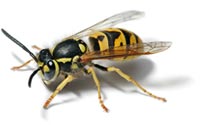Curiosities: Why are yellow jackets most noticeable in late summer?

Often mistaken for bees, German yellow jackets are social wasps that cooperate to build their nests and support their queen, and they can be formidable in defending their turf. A yellow jacket nest begins in the spring with a single queen. “She has to build the nest, get the food and raise the first batch of workers in May and early June,” notes UW–Madison entomologist Phil Pellitteri.
As adults, the workers do most of the heavy lifting to keep the nest defended and supplied with food. Meanwhile, the queen lays more eggs and the colony grows. By the end of the summer, the colony can have hundreds of workers and a growing need for food.
“Most of the food for the larvae at this time of year are other insects, things like caterpillars and flies,” Pellitteri explains. But the heavy demand for sustenance, Pellitteri adds, can sometimes turn yellow jackets into scavengers, and they will seek out protein for their larvae and sugar-based products like soda and juice for their own energy needs.
“So food and drink become fair game,” says Pellitteri. “This brings the larger number of yellow jackets at this time of year into close contact with people as the insects seek out ripe fruit, garbage cans and other sources of food and energy.”
Tags: curiosities, entomology



